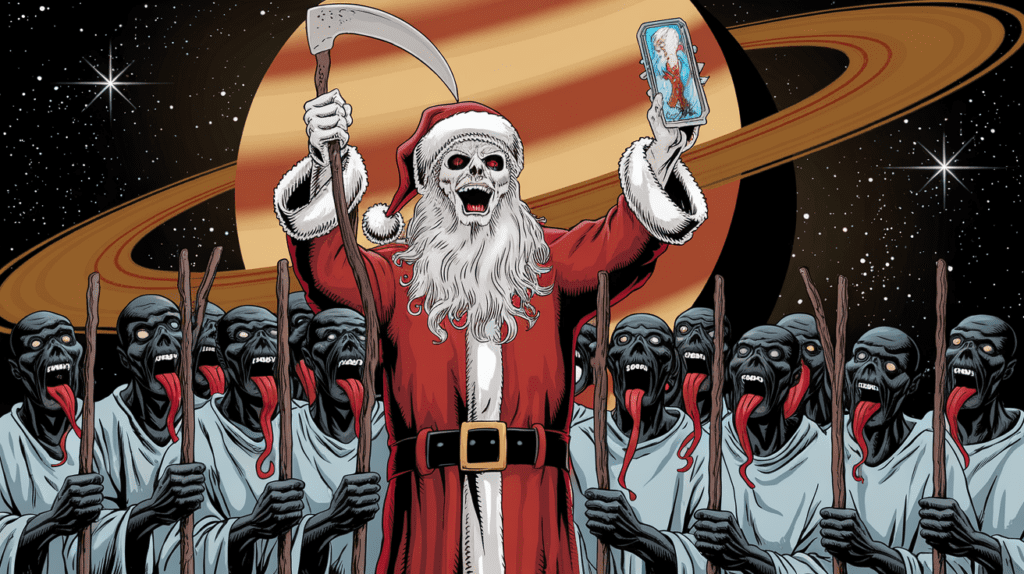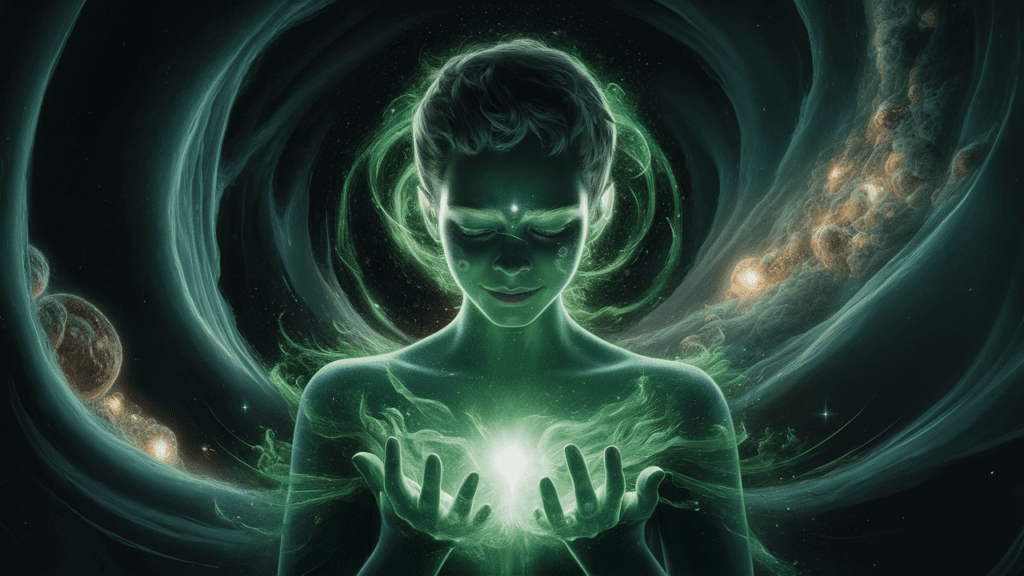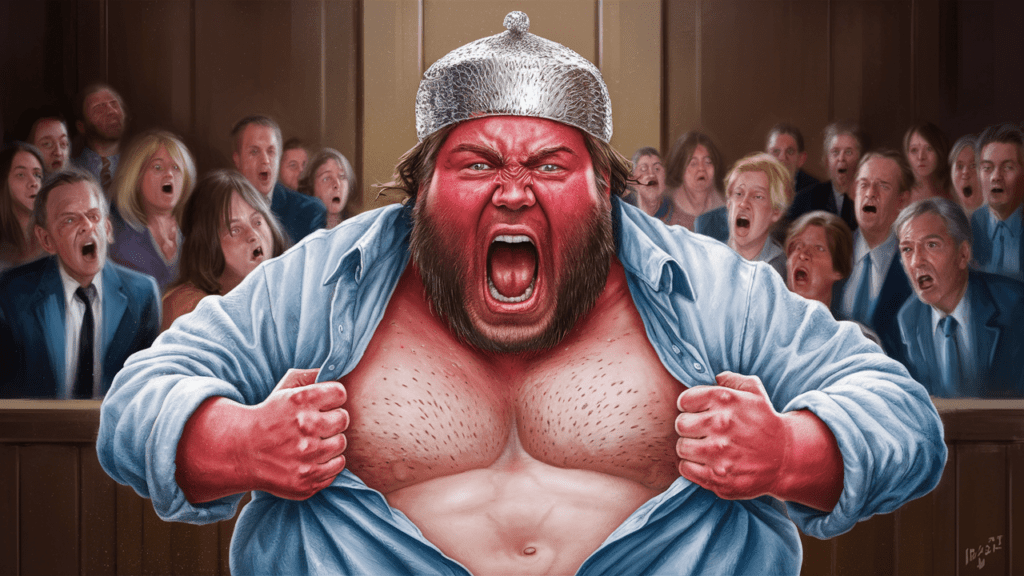As December rolls in, the festive season fills the air with joy, gift-giving, and the ever-familiar figure of Santa Claus. But behind the jolly red suit, reindeer, and cheerful demeanor lies an ancient, layered story rooted in astrology, mythology, and the occult. Santa Claus, or Saint Nicholas, is more than a symbol of holiday cheer—he’s deeply tied to Saturnalia, Father Time, and Karmic justice, all connected to the old god Saturn.

From the Saturnalian traditions of ancient Rome to the folklore of Nordic Europe and the controversial figure of Sinterklaas in the Netherlands, this post unpacks the history, symbolism, and astrological significance of Santa Claus as a figure of karma and consequence.
Saturnalia: The Festival of Saturn
The origins of Santa Claus can be traced back to the Roman festival of Saturnalia, celebrated from December 17th to December 23rd. Saturnalia honored Saturn, the god of agriculture, wealth, and time. Saturn was depicted as an old man with a long white beard, representing wisdom, age, and the cyclical nature of time.
During Saturnalia, societal norms were temporarily overturned:
• Masters served their slaves.
• People exchanged gifts.
• Feasting and revelry blurred class distinctions.
This chaotic yet joyful celebration laid the foundation for the modern holiday season. However, the deeper essence of Saturnalia wasn’t just about merriment—it was about karma. Saturn, as the god of time, also ruled over the law of cause and effect, rewarding or punishing based on one’s actions.
Santa Claus and Saturn: The Archetype of Karma
The figure of Santa Claus aligns closely with Saturn in several ways:
1. The Old Man with a Beard: Saturn, often depicted as an elder with a long white beard, symbolizes the passage of time and karmic judgment. Similarly, Santa Claus is portrayed as an old, wise man who “knows when you’ve been bad or good.”
2. Karmic Rewards and Punishments: Santa brings gifts to the well-behaved children but coal—or worse—for the naughty ones. This reflects Saturn’s role as the dispenser of karmic justice, ensuring that actions align with their consequences.
3. Astrological Significance: In astrology, Saturn rules over Capricorn, a sign associated with discipline, responsibility, and karma. December is under Capricorn’s influence, making Saturn’s themes of reckoning and reward particularly relevant during this time of year.
Saint Nicholas, Krampus, and the Dark Side of Santa
Before Santa Claus became a commercialized symbol of generosity, he was Saint Nicholas, a 4th-century bishop celebrated for his charitable deeds. In Nordic European folklore, Saint Nicholas traveled with a companion: the demon-like figure Krampus.
• Krampus was responsible for punishing misbehaving children, contrasting Saint Nicholas’s benevolence. This duality of light (reward) and dark (punishment) echoes Saturn’s karmic nature.
• In the Netherlands, Saint Nicholas became Sinterklaas, who brings gifts on December 5th, accompanied by Zwarte Piet (Black Pete)—a controversial figure rooted in older myths of Krampus but adapted into a blackened servant or “helper.”
The dichotomy of reward and punishment during these celebrations reinforces Saturn’s role as the ultimate judge of one’s actions.
Santa Claus and Father Time: The Saturn Connection
Santa Claus is often associated with Father Time, another archetype of Saturn. Both represent the passing of time and the cyclical nature of life:
• Father Time carries a scythe, much like the Grim Reaper, symbolizing death as the natural conclusion of time.
• Santa, meanwhile, is tied to the end-of-year festivities, marking the close of one cycle and the preparation for the next.
Through this lens, Santa Claus becomes more than a cheerful holiday figure—he represents the weight of time, karma, and the need to reflect on our actions before the year resets.
Astrological and Occult Symbolism
From an astrological perspective, the holiday season carries significant symbolism:
• Saturn’s Influence: As the ruler of Capricorn, Saturn governs the darkest days of the year in the Northern Hemisphere. These long nights invite introspection, mirroring Saturn’s themes of accountability and inner growth.
• The Winter Solstice: Celebrated on December 21st, the solstice marks the rebirth of the sun—a theme deeply tied to Saturnalia. It represents a transition from darkness to light, mirroring the process of karmic reckoning and renewal.
Occult traditions also recognize Saturn as the keeper of boundaries—both physical and spiritual. Santa Claus’s role as the judge of children’s behavior parallels Saturn’s function as the enforcer of universal law, ensuring that no action goes without consequence.
The Dual Nature of Santa: Light and Dark
Santa Claus, as we know him today, is a sanitized version of his more complex, dualistic origins. He embodies both the light of generosity and the darkness of karmic consequence:
• His jolly, giving nature reflects the festive joy of Saturnalia.
• His role as a judge, deciding who is “naughty or nice,” reflects the karmic accountability Saturn demands.
In this duality, Santa Claus reminds us of an essential truth: life is a balance of light and dark, and our actions shape the rewards or challenges we face.
From Saturnalia to the Shopping Mall
Over time, the deeply symbolic figure of Saturn/Santa has been transformed into a commercialized icon, stripped of much of his esoteric meaning. The festive season has shifted from a time of reflection and karmic reckoning to one of consumerism and distraction.
However, understanding the origins of Santa Claus allows us to reconnect with the deeper significance of this season. It’s a time to reflect on our actions, realign with our purpose, and embrace the lessons Saturn offers: discipline, responsibility, and the understanding that we create our own karma.
Unmatrix Yourself This Holiday Season
The holiday season is more than just a time for gifts and celebrations—it’s an opportunity to step back, reflect, and realign. By understanding the ancient roots of Santa Claus and Saturnalia, we can move beyond the superficial trappings of the season and reconnect with its deeper, spiritual purpose.
For more insights into the hidden truths of our world and guidance on breaking free from societal illusions, explore A Guide to Unmatrix Yourself.
Join the Unmatrix Tribe on Instagram, YouTube, and Reddit as we uncover the layers of history, astrology, and spirituality that shape our world.
This holiday season, let’s move beyond the shadows and embrace the light of understanding.


